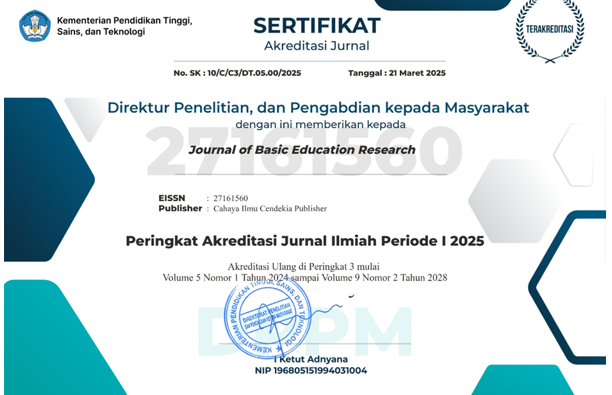Countdown Manipulatives: Accelerating the Subtraction Proficiency of the Grade Two Pupils
Abstract
Purpose of the study: This study aimed to improve the mastery of subtraction among Grade 2 pupils at Bahong Elementary School through the use of countdown manipulative materials: Take-off Visualization, Improvised Wheel Clock Count, and Sequential Ladder Count.
Methodology: The respondents consisted of 32 Grade 2 pupils, and data were gathered using pretest and posttest questionnaires. Descriptive statistics and a t-test were used for data analysis. The results revealed that the pupils' mastery level in subtraction improved significantly after the intervention, with the overall posttest Mean Percentage Score (MPS) reaching 93.81%, which is described as "Closely Approximating Mastery." A paired t-test analysis indicated a significant difference in the learners' performance before and after using the manipulative materials, demonstrating the effectiveness of the intervention.
Main Findings: The study found that countdown manipulatives effectively improved Grade 2 pupils’ subtraction skills, with the Improvised wheel clock count being the most preferred due its simplicity. These tools helped bridge learning gaps and enhance mathematical understanding. The findings highlight the value of using intercative and innovative materials to boost learner engagement and performance in mathematics.
Novelty/Originality of this study: The originality of this study lies in its innovative use of countdown manipulative materials, Take-off Visualization, Improvised Wheel Clock Count, and Sequential Ladder Count to enhance subtraction mastery among Grade 2 pupils. Unlike traditional teaching methods, these manipulatives provide interactive, visual, and hands-on learning experiences tailored to young learners.
References
A. A. Abarquez, “The Use of Manipulative in Teaching Elementary Mathematics,” International Journal of Linguistics, Literature and Translation (IJLLT), 2020. doi: 10.32996/ijllt.2020.3.11.3
M. Boz, S. Erdogan, and G. Uludag, “The Effect of the Manipulative Materials on the Early Mathematics Skills,” Bartin University Journal of Faculty Education, vol. 9, no. 3, pp. 492–500, 2020, doi: 10.14686/buefad.620085.
E. Fischbein,” Intuition in Science and Mathematics: An Educational Approach, Dordrecht,” The Netherlands: Kluwer, 2007.
J. Hornigold, “How Important is Number Sense? (Turns out, very),” Teaching Practice, USA, 2021.
P. Jenkins, “The Leading Strategies on Mathematics Graduate Research papers 915,” Lincoln Elementary School, 2005.
E. Larbi, “The Use of Manipulatives in Mathematics Education,” Journal Education and Practice, vol. 7, no. 36, pp. 12–17, 2016.
K. Larkin, “Mathematics Education and Manipulatives,” Australian Primary Mathematics Classroom, vol. 21, no. 1, pp. 12–17, 2016.
J. Longson, “The Use of Manipulative in Teaching Elementary Mathematics,” 2003.
B. Mijares III, “Factors Affecting the Academic Performance of the Learners in Mathematics Amidst Pandemic,” Psychology and Multi-disciplinary Journal, vol. 5, 2022.
S. Nalagon, “Education in a Times of Pandemic,” 2021. doi: 10.5281/zenodo.7337795
N. O’meara, A. Leavy, and P. Johnson, “A Comparative Study Investigating the Use of Manipulatives at Transition from Primary to Post-Primary Education,” International Journal of Mathematical Education in Science & Technology, vol. 51, no. 2, pp. 1–23, 2019, doi: 10.1080/0020739X.2019.1634842.
Pagaran, Gabriel M., et al. Mathematics performance of senior high school students in blended learning amidst the Covid-19 pandemic. Journal of Positive School Psychology, 2022, 10593-10613.
O. Quillao, “Improving the Problem-Solving Skills of Grade 6 Pupils of Balaoan Central School through Cooperative Learning Strategies,” Action Research, DepEd Balaoan District, 2014.
I. Rivera, “Correlates of Pupils Competency in Solving Word Problems in Mathematics VI,” Master’s Thesis, Osias Educational Foundation, Balaoan, Launion, 2011.
C. Ross, “The Effect of Mathematical Manipulative Materials on Third Grade Students’ Participation, Engagement and Academic Performance,” Electronic Theses and Dissertations, 2008.
Salandanan, Gloria G. The teaching of science and health, mathematics, and home economics, and practical arts. Goodwill Trading Co., Inc., 1996.
ALPACION, N., et al. Attitude, self-efficacy and students’ academic performance in mathematics. IAMURE International Journal of Social Sciences, 2014, 12.1: 21-34. doi: 10.7718/ijss.v12i1.920
R. Yilmaz, “Visualization in the Mathematical Abstraction and Generalization Processes and Its Importance,” Unpublished Doctoral Dissertation, Gazi University, Ankara, 2011.
R. Yilmaz and Z. Argun, “Role of Visualization in Mathematical Abstraction: The Case of Congruence Concept,” vol. 6, 2018, doi: 10.18404/ijemst.328337.
M. Baclig, “TIMSS 2019: Philippines Results and Implications,” DepEd Research Brief, 2020.
R. Leongson, “Filipino Learners’ Strengths and Weaknesses in Mathematics,” Philippine Journal of Educational Studies, vol. 45, no. 2, pp. 123–138, 2019.
S. Fleisch, Primary Education in South Africa: Contexts, Trends and Challenges, Cape Town: HSRC Press, 2008.
National Council of Teachers of Mathematics (NCTM), “Using Manipulatives to Support Student Learning,” NCTM Position Statement, 2014.
J. Shaw, “Manipulatives Strengthen Relationships Between Mathematical Ideas and Support Long-Term Retention,” Journal of Math Education, vol. 32, no. 1, pp. 11–18, 2017.
A. Copley, “The Role of Manipulatives in Constructivist Learning,” Educational Studies in Mathematics, vol. 78, no. 3, pp. 387–406, 2011, doi: 10.1007/s10649-011-9339-4.
R. Barrera, “Impact of Manipulative-Based Teaching on Student Achievement,” International Journal of Education, vol. 9, no. 2, pp. 200–210, 2015.
J. Marley and M. Selig, “Physical Interaction with Mathematical Tools Helps Encode Information Visually and Kinesthetically,” Learning and Instruction, vol. 40, pp. 1–9, 2016, doi: 10.1016/j.learninstruc.2015.08.002.
M. Boz, S. Erdogan, and G. Uludag, “Manipulative Use Positively Impacts Early Mathematical Development,” Bartin University Journal of Faculty Education, vol. 9, no. 3, pp. 492–500, 2020, doi: 10.14686/buefad.620085.
A. Biotenbeck, “Instructional Strategies and Mathematics Achievement,” Educational Research Quarterly, vol. 28, no. 3, pp. 45–58, 2016.
J. Clement, “Teachers’ Practices and Student Achievement in Mathematics,” International Journal of Educational Development, vol. 38, pp. 17–24, 2014, doi: 10.1016/j.ijedudev.2014.05.002.
M. Tata, “Factors Affecting Mathematics Achievement in Nigerian Secondary Schools,” Journal of Educational Psychology, vol. 15, no. 2, pp. 34–42, 2017.
V. Vetter, “Descriptive Statistics: Understanding Your Data,” Journal of Statistical Education, vol. 25, no. 2, pp. 1–12, 2017, doi: 10.1080/10691898.2017.1320193.
Department of Education (DepEd), “DepEd Memorandum No. 160, s. 2012: Policies on the Mastery Level for MPS,” 2012.
E. Barrera, “Manipulative Use in Mathematics: Student Engagement and Performance,” Philippine Journal of Education, vol. 22, no. 1, pp. 55–67, 2018.
O. M. Quillao, “Cooperative Learning Strategies and Mathematics Problem-Solving,” Philippine Action Research Journal, 2014.
I. Rivera, “Pupils Competency in Solving Word Problems in Mathematics,” Master’s Thesis, Osias Educational Foundation, 2011.
C. Ross, “Mathematical Manipulative Materials and Student Engagement,” Electronic Theses and Dissertations, University of Central Florida, 2008.
Salandanan, Gloria G. Teaching Approaches & Strategies. Goodwill Trading Co., Inc., 2008.
R. Tudy, “Attitude, Self-Efficacy, and Academic Performance in Mathematics,” IAMURE International Journal of Social Sciences, vol. 12, 2014.
YILMAZ, Rezan; ARGUN, Ziya. Role of Visualization in Mathematical Abstraction: The Case of Congruence Concept. International Journal of Education in Mathematics, Science and Technology, 2018, vol. 6, no. 1: 41-57, doi: 10.18404/ijemst.328337.
Copyright (c) 2025 Rosendra Alicwas Berry

This work is licensed under a Creative Commons Attribution 4.0 International License.
Authors who publish with this journal agree to the following terms:
- Authors retain copyright and acknowledge that the Journal of Basic Education Research is the first publisher licensed under a Creative Commons Attribution 4.0 International License.
- Authors are able to enter into separate, additional contractual arrangements for the non-exclusive distribution of the journal's published version of the work (e.g., post it to an institutional repository or publish it in a book), with an acknowledgment of its initial publication in this journal.
- Authors are permitted and encouraged to post their work online (e.g., in institutional repositories or on their website) prior to and during the submission process, as it can lead to productive exchanges and earlier and greater citation of published work.





.png)


.png)
.png)


















